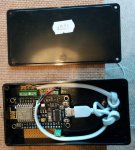Hi everyone, Happy New Year.
I am struggling to get repeatable behaviour for my project and I wonder whether it might be some dampness which causes the lack of repeatability and I might have broken the "best practice for external installations". Could someone please offer advice?
Here is a description of my problem
The hardware (see picture):
I have installed a NodeMCU board (which has an ESP 8266 on board) mounted to the outside wall of the gas meter enclosure, transmitting via WiFi across the garden. The board is mounted inside an ABS enclosure taped shut with electrical tape. I have drilled a hole at the back of the box and glued a plastic tube to it. The tube is inserted into the ventilation brick of the meter room. Cabling for sensors and power supply goes through the tube. So no water can enter the board enclosure. Ventilation is possible through the tube, but the meter room is warmer than outside.
Sensor and software.
The hall switch sensor mounted on the gas meter picks up the passing of the magnet on the meter wheel and triggers an interrupt. The resulting action is to connect to a web server (via WiFI) and upload the number of pulses since boot/reboot . There is a loop that checks for existence of a connection to the router and the NodeMCU IP address. In case of loss of IP, attempts to reconnect are made. If after a number of attempts the WiFi connection cannot be restored, then a NodeMCU reboot is performed. Pulses happen every 2-3 minutes.
The problem observed:
The board performs normally for one or two days, with very sporadic reboots. Then the problems start. the pulse uploads will stop, but no restart will happen and the pulses will still be counted. Every few hours an upload would take place (randomly) confirming that the number of pulses is correctly tracked. This suggests to me that the IP address is retained (So a reboot is not triggered ), but communication with the server is failing and no pulse can be uploaded.
My guess ...
... is that there is a deterioration is signal strength cause by some factor related to the installation (If I take the board inside and connect it to the PC to check the software all seems normal).
Could this be the case?
Should I cover the board and connectors with some waterproof substance, like silicone or similar?
Any other suggestions?
I would really appreciate some help, as I have run out of Ideas.
Many Thanks
Riccardo
I am struggling to get repeatable behaviour for my project and I wonder whether it might be some dampness which causes the lack of repeatability and I might have broken the "best practice for external installations". Could someone please offer advice?
Here is a description of my problem
The hardware (see picture):
I have installed a NodeMCU board (which has an ESP 8266 on board) mounted to the outside wall of the gas meter enclosure, transmitting via WiFi across the garden. The board is mounted inside an ABS enclosure taped shut with electrical tape. I have drilled a hole at the back of the box and glued a plastic tube to it. The tube is inserted into the ventilation brick of the meter room. Cabling for sensors and power supply goes through the tube. So no water can enter the board enclosure. Ventilation is possible through the tube, but the meter room is warmer than outside.
Sensor and software.
The hall switch sensor mounted on the gas meter picks up the passing of the magnet on the meter wheel and triggers an interrupt. The resulting action is to connect to a web server (via WiFI) and upload the number of pulses since boot/reboot . There is a loop that checks for existence of a connection to the router and the NodeMCU IP address. In case of loss of IP, attempts to reconnect are made. If after a number of attempts the WiFi connection cannot be restored, then a NodeMCU reboot is performed. Pulses happen every 2-3 minutes.
The problem observed:
The board performs normally for one or two days, with very sporadic reboots. Then the problems start. the pulse uploads will stop, but no restart will happen and the pulses will still be counted. Every few hours an upload would take place (randomly) confirming that the number of pulses is correctly tracked. This suggests to me that the IP address is retained (So a reboot is not triggered ), but communication with the server is failing and no pulse can be uploaded.
My guess ...
... is that there is a deterioration is signal strength cause by some factor related to the installation (If I take the board inside and connect it to the PC to check the software all seems normal).
Could this be the case?
Should I cover the board and connectors with some waterproof substance, like silicone or similar?
Any other suggestions?
I would really appreciate some help, as I have run out of Ideas.
Many Thanks
Riccardo
Attachments
-
147.5 KB Views: 58
-
89.6 KB Views: 44


